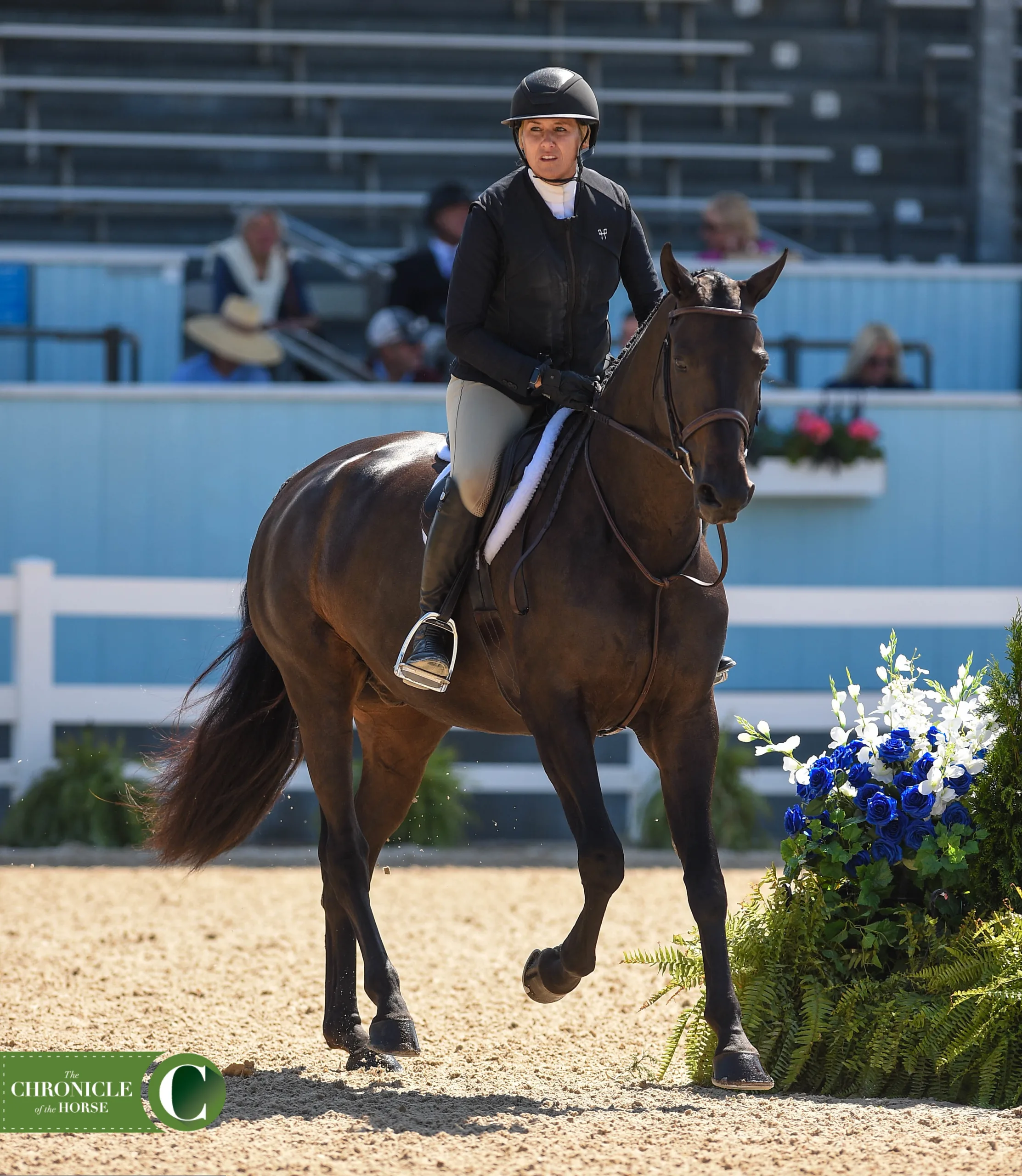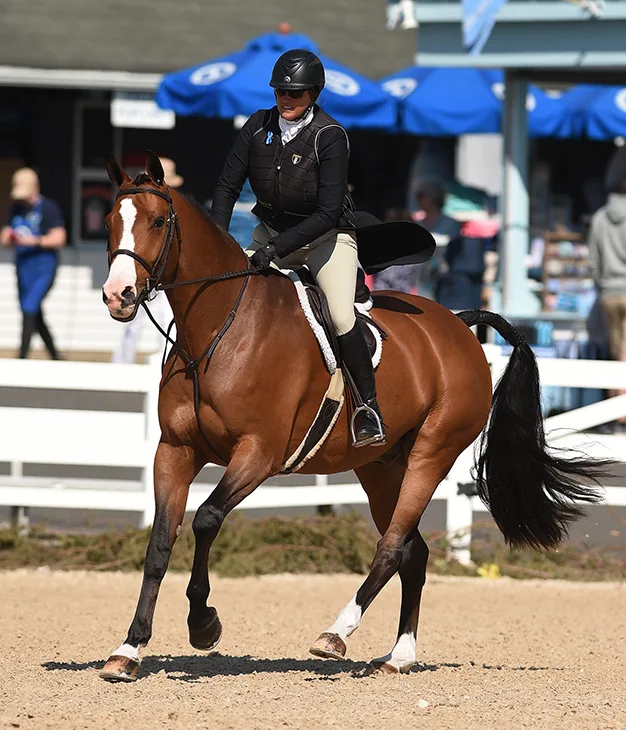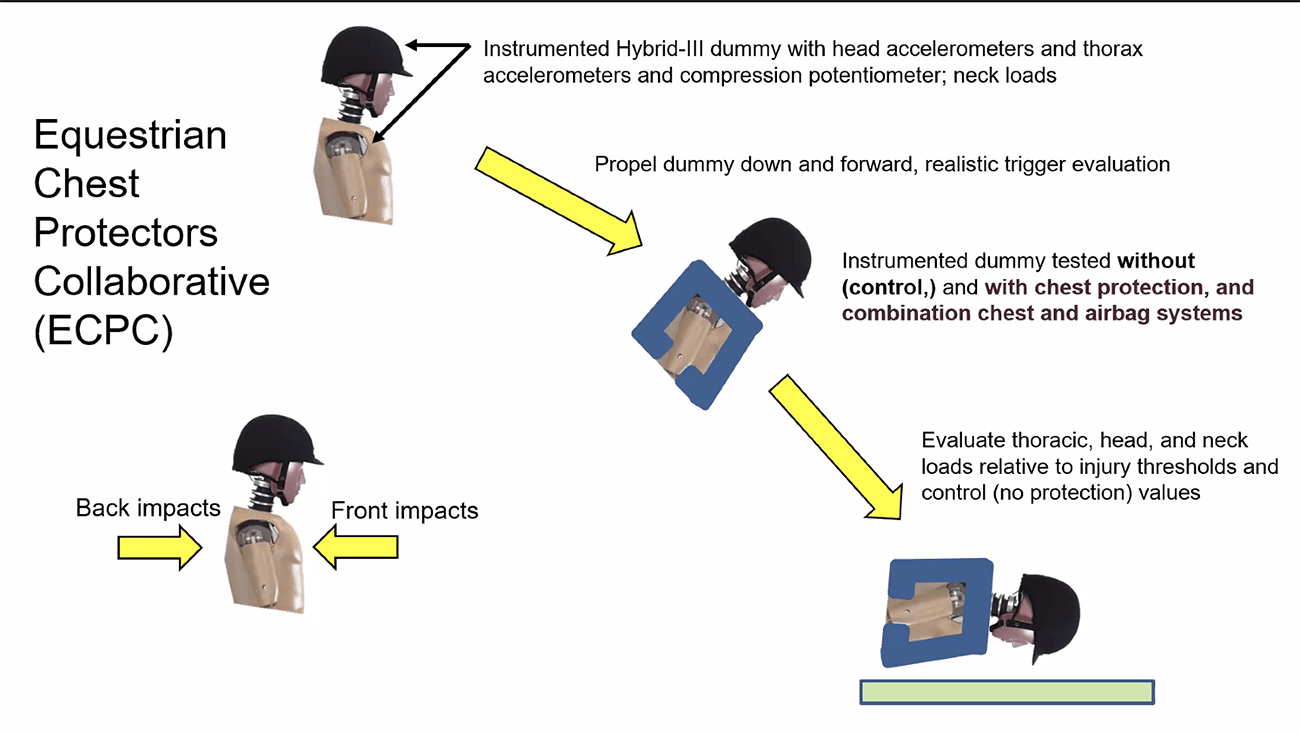Once virtually unseen at hunter/jumper shows, safety vests are now part of standard show ring attire for many riders, from juniors and amateurs to hunter professionals and international show jumpers. Instead of the full ASTM-certified body protectors required in eventing, air vests tend to be the equipment of choice in the show ring, either worn over or built into a hunt coat.
While the lightweight vests are increasingly popular, there are no standards governing their testing or performance in the United States, making it impossible to know how effective they are beyond anecdotal evidence. The U.S. Hunter Jumper Association is hoping to change that with a new research effort and accompanying fundraising campaign launched this week in cooperation with the Virginia Tech Helmet Lab.
The two-year project will cost an estimated $825,000, half of which must be raised for research to begin. In announcing its Equestrian Safety Vest Research Campaign this week, USHJA has set an initial goal of $450,000 and pledged $100,000 to start.

The Virginia Tech Helmet Lab has conducted independent research on helmets used in a variety of sports, and in December it released its highly anticipated equestrian helmets ratings following another a two-year study that was funded thanks to efforts spearheaded by the U.S Equestrian Federation, USHJA and U.S. Eventing Association. The university also has conducted extensive research in the automotive industry, including looking at air bags and seatbelts, which will help inform the tests used on equestrian vests.
USHJA coupled the research campaign launch with a Tuesday webinar titled “Upping the Standard of Equestrian Air Vests.” USHJA Safety Committee chair Joe Dotoli hosted the webinar with Dr. Stefan Duma, the executive director of the Virginia Tech Institute for Critical Technology and Applied Science and the founder of the Virginia Tech Helmet Lab, and Dr. Barry Miller, the director of outreach and business development at the Virginia Tech Helmet Lab, to discuss the newest initiative.
Virginia Tech will evaluate body protectors, air vests, and the two used together. The study will look at the effectiveness of each, as well as the trigger mechanism in air vests to determine if they are sufficient or if there’s room for improvement. Questions they’ll consider include whether the vests inflate fast enough and whether they inflate before a rider hits the ground.
ADVERTISEMENT

Much like the helmet tests, the new study will happen in three phases—data collection, testing methodology development and testing—over two years.
In the data collection phase, researchers will analyze current equestrian standards and relevant chest injury standards for all types of vests, as well as current testing methods used by ASTM International and similar European bodies, including British Equestrian Trade Association and the U.K.-based independent testing organization SATRA. They also will evaluate injury reports and videos of falls to determine the most common types of chest impact and injury patterns.
This data will be used in Phase 2 to help researchers develop their own testing methodologies. Duma said that the ASTM vets body protectors by taking a 5 kilogram (about 11 pounds) head form used to test helmets and, from the height of about half a meter, dropping it onto a vest placed over a metal plate. While such an impact might correlate to a hit like a kick, he said, it does not reflect the impact of a fall from a horse, which is done from a much greater height.
The Virginia Tech lab intends to use a an upper body, or thorax, form with an attached head and neck in its testing. Including the head and neck will allow researchers to also evaluate the effect a given vest—an inflated air vest, for example—has on those body parts in a fall, Duma said.
“A lot is going to be driven by Phase 1,” he said. “What are the injuries? What are the numbers and types of injuries? Maybe there are common tailbone fractures we need to consider.”
If the data indicates it is necessary, researchers could add a full upper body and pelvis to their testing dummy.
ADVERTISEMENT

During the third phase, testing will focus on rating the biomechanical performance of the chest protectors.
“[We’ll evaluate] to a baseline,” he said. “This is going to be: What does it look like with no protection? Then put protection on it and see how much the fall was cushioned. Was the acceleration lower? What happens to the head? We can envision it helping the head, but we don’t want it to cause the head to increase impact. The goal is to have all those answers in 24 months.”
However, before the research can happen, money must be raised to fund it. USHJA has committed $100,000 toward the first $450,000 of the $825,000 project needed to let work begin. People interested in donating toward the effort can do so here.
Equestrians willing to contribute their own fall data to the study were told they could email video (either by link or digital file) and other relevant information to Miller at bmiller21@vt.edu.
Dotoli mentioned that USHJA is working in collaboration with USEF and the Fédération Equestre Internationale on moving this project forward. He also said the USEA expressed interest, and during the USEA Annual Meeting last December, USEA CEO Rob Burk shared that USEA Safety Committee member Kaitlin Spak had been speaking with the helmet lab about collecting data on vests.
As to whether this research effort indicates a rule change on the horizon that would mandate safety vests, Dotoli, who spearheaded the effort to get helmets mandated in 2001, said USHJA is a long way from that.
“We can’t have a rule until we know what we’re making a rule about,” he said. “We can’t have a rule until we consider what the vests do. Let’s figure out how they work, if they work, which one works the best. Do I see it in the future? Possibly, but certainly not until we know a lot more.”














